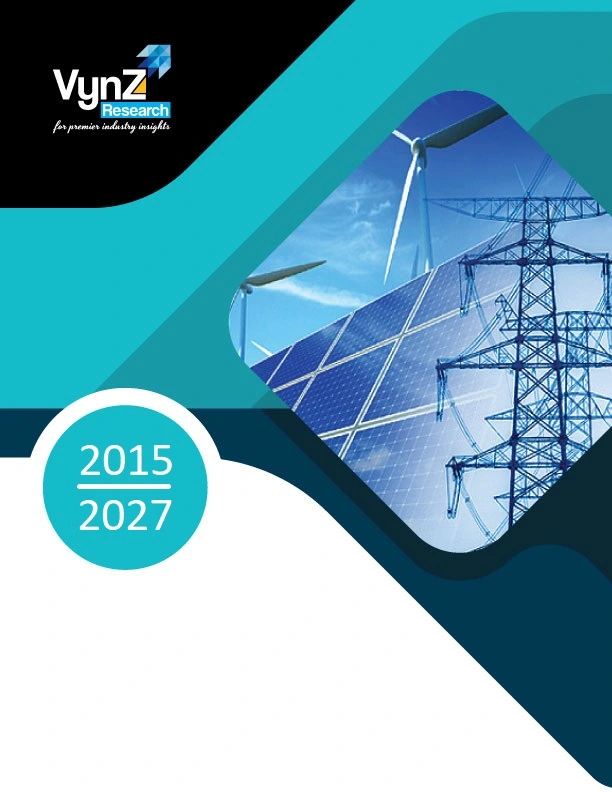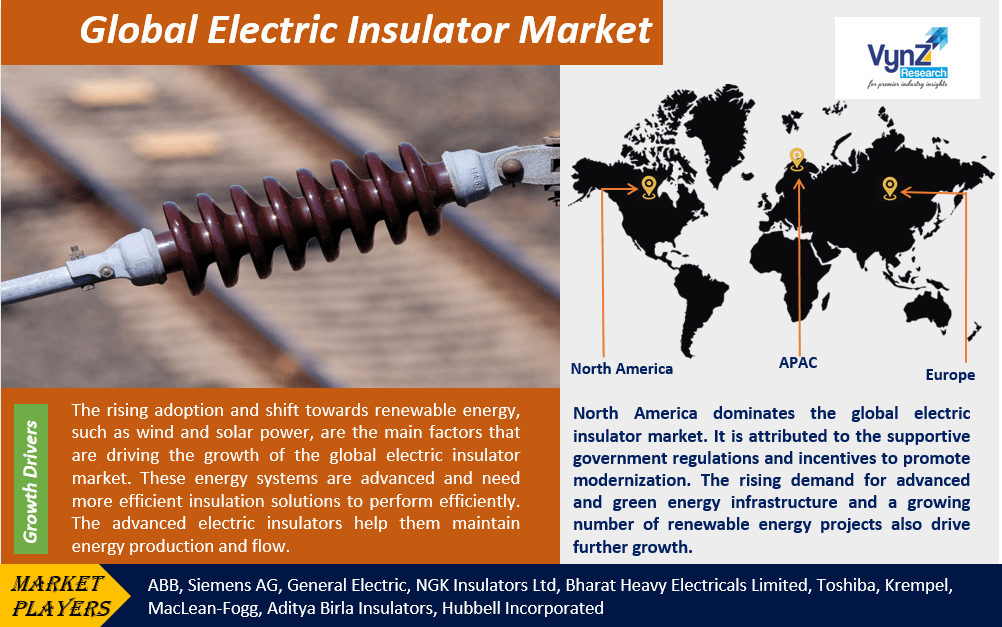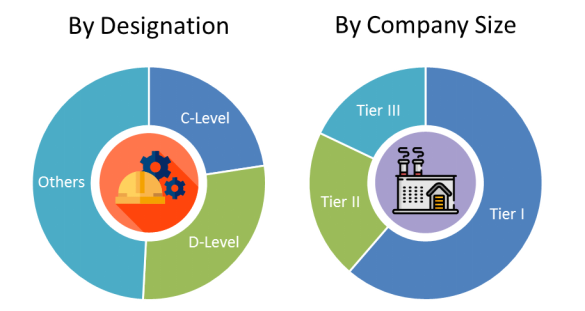| Status : Published | Published On : Nov, 2024 | Report Code : VREP3041 | Industry : Energy & Power | Available Format :

|
Page : 197 |

Global Electric Insulator Market Size & Share | Growth Forecast Report 2030
Industry Insights By Material (Ceramic/Porcelain, Glass, Composite), By Voltage (Low, Medium, and High ), By Application (Transformers, Switchgears, Cables & Transmission Lines, Bus Bars, and Others), By Product (Pin Insulators, Shackle Insulators, Suspension Insulators), By End Use (Utilities, Residential, and Commercial & Industrial) and By Geography (North America, Europe, Asia Pacific, Rest of the World)
Industry Overview
The global electric insulator market size was valued at USD 14.2 billion in 2023. It is likely to grow up to USD 21.6 billion by 2030 at a CAGR of 5.8% during the forecast period ranging between 2025 and 2030. The rapid urbanization drives in developing countries and the significant rise in the number of electrification projects in emerging economies are the major factors that drive the growth of the market. This is mainly attributed to the growing need for a robust and more efficient power infrastructure and uninterrupted supply. The continually rising demand for electricity requires reliable electric insulators to maintain the functionality of power transmission systems. Insulators are mainly used in transformers, circuit boards, power lines, and electronic devices to prevent loss of energy and chances of short circuits. It, therefore, protects the devices from electric hazards and enhances their performance and reliability.

The material or the specific component that limits the flow of electric current is called an electric insulator. The primary function of these insulators is to promote safety, security, and operational efficiency of electrical systems. These insulators are usually available in plastic, glass, ceramic, and rubber materials. A few insulators are designed with advanced insulation technologies to incorporate composite polymers and other materials to enhance their durability. These materials also improve their resistivity, enabling them to perform at the same level even in extreme conditions. Such features allow these insulators to be used in telecommunications, power generation, and even construction equipment to maintain stability in energy distribution and support contemporary electrical infrastructure.
Global Electric Insulator Market Report Coverage
|
Report Metric |
Details |
|
Historical Period |
2018 - 2023 |
|
Base Year Considered |
2024 |
|
Forecast Period |
2025 - 2030 |
|
Market Size in 2024 |
U.S.D. 14.2 Billion |
|
Revenue Forecast in 2030 |
U.S.D. 21.6 Billion |
|
Growth Rate |
5.8% |
|
Segments Covered in the Report |
By Material, By Voltage, By Application, By Product and By End Use |
|
Report Scope |
Market Trends, Drivers, and Restraints; Revenue Estimation and Forecast; Segmentation Analysis; Impact of COVID-19; Companies’ Strategic Developments; Market Share Analysis of Key Players; Company Profiling |
|
Regions Covered in the Report |
North America, Europe, Asia Pacific and Rest of the World |
Global Electric Insulator Industry Dynamics
Global Electric Insulator Market Trends/ Growth Drivers:
Growing adoption of renewable energy
The rising adoption and shift towards renewable energy, such as wind and solar power, are the main factors that are driving the growth of the global electric insulator market. These energy systems are advanced and need more efficient insulation solutions to perform efficiently. The advanced electric insulators help them maintain energy production and flow. The growing investment in renewable energy and green grids has also increased the adoption of electric insulators to meet the strict regulations of the governments for net-zero emissions. These insulators increase the safety of the systems and their reliability due to lower energy loss during transmission. This is especially helpful in high-voltage systems. These insulators are also crucial to prevent electrical shorts and faults in demanding setups, thereby pushing demand, use, and market growth.
Other significant growth drivers of the market include development in technologies, the rise of smart grids, IoT integration into modern power systems, and growing demand for high-performing insulators. Also, the rising focus on green energy, higher demand for stability in smart grids and energy efficiency, and rapid modernization of old infrastructure in developed countries fuels the market growth. Furthermore, rising industrialization drives innovations all over the world in lightweight and eco-friendly materials that promote functionality and product performance, and growing concerns over environmental impacts increase the demand for efficient insulators and the growth of the market.
Global Electric Insulator Market Challenges
High cost of systems and maintenance
The most significant challenge of the global electric insulator market that is hindering its rapid growth is the high cost of systems and their continual maintenance. These efficient and innovative insulation solutions are made of the finest materials, such as ceramics, composites, and others, that are extremely durable but come at a high cost. This deters widespread adoption of these insulators, especially for smaller economies and budget-controlled projects. Another growth challenge of the market is the inability of these insulators to endure wear and tear in harsh settings such as renewable energy and high-voltage lines. This necessitates regular repair and maintenance to ensure safety and uninterrupted operation, which adds to the cost of operation. Furthermore, the technical complexity of integrating these insulators into old infrastructure prevents the widespread use of these insulators and the growth of the market.
Global Electric Insulator Market Opportunities
Increasing demand for smart grid incorporation
The growing demand for incorporating smart grids offers significant growth opportunities to the global electric insulator market. This is mainly attributed to the rising modernization drive of the aging power infrastructure all over the world to make energy distribution systems more efficient. In addition, the need for such effective and reliable insulators by the smart grids to increase energy efficiency, support automation, and facilitate real-time monitoring, along with the rising demand for specialized insulators in renewable energy projects for solar and wind power applications, offers novel growth opportunities. The developing markets of Asia and Africa also present significant growth potential due to rapid industrialization initiatives, urbanization drives, and higher electrification requirements. Technological and material innovations also support eco-friendly and more sustainable solutions to cater to the stringent environmental regulations and growing consumer demand for green and clean energy infrastructure.
Recent Developments By The Key Players:
ABB has completed a second strategic investment in US-based technology company Pratexo (an edge-to-cloud software solution provider) to create digital solutions for enhanced supply and demand balancing.
Siemens expands Wendell facility for innovation and decarbonization. The company has invested USD 36 million to enhance customer experience, manufacturing, and training efforts, and underpins commitment to decarbonization.
Global Electric Insulator Market Segmentation
VynZ Research provides an analysis of the key trends in each segment of the Global Electric Insulator Market report, along with forecasts at the regional and country levels from 2025-2030. Our report has categorized the market based on material, voltage, application, product and end use.
Insight by Material
- Ceramic/Porcelain
- Glass
- Composite
The ceramic or porcelain segment dominates due to cost-effectiveness
The global electric insulator market is segregated by material into Ceramic or Porcelain, Glass, or Composite categories. Out of these segments, the most dominating segment is ceramic or porcelain. This is because these insulators are cost-effective, durable, mechanically strong, and resistive to chemical and temperature difference. It ensures reliability in operations of transmission lines, substations, and other high-voltage applications.
Insight by Voltage
- Low
- Medium
- High
The high voltage insulators segment dominates due to usefulness
According to the voltage, the global electric insulator market is divided into Low, Medium, and High Voltage Insulators categories. Among all these, the high voltage insulators segment dominates the market due to its crucial role and usefulness in electricity transmission over a long distance. These insulators are needed to meet the growing need for continual power supply to support the rapid urbanization and industrialization drives, especially in developing countries like India and China. These insulators are essentially required in the renewable energy grids of the wind and solar farms to transfer energy generated in remote areas and connect these sites to the city distribution centers.
Insight by Application
- Transformers
- Switchgears
- Cables & Transmission Lines
- Bus Bars
- Others
The cables & transmission lines segment dominates due to higher application
The global electric insulator market is split by application into Transformers, Switchgears, Cables & Transmission Lines, Bus Bars, and other segments. Out of them, the cables & transmission lines segment dominates the market due to higher application, modernization, and grid expansion efforts. Also, the ability of these insulators to reduce energy loss in long-distance energy transmission, ensuring efficiency and safety, the rising need in the renewable energy sectors to support smart grids, and innovative technologies that enhance operation efficiency drive their adoption. Their dominance is also underscored by their ability to operate seamlessly in diverse environments and weather conditions.
Insight by Product
- Pin Insulators
- Shackle Insulators
- Suspension Insulators
The pin insulator segment dominates due to widespread adoption
Different products divide the global electric insulator market into Pin Insulators, Shackle Insulators, Suspension Insulators, etc. The pin insulator segment is more dominating and is expected to grow more during the forecast period due to cost-effectiveness, durability, widespread adoption in low and medium-voltage distribution networks, easy installation, and suitability in use in distribution lines in urban as well as in rural settings to support their rapid industrialization and urbanization drives. More importantly, these insulators can endure environmental stress, which further increases its demand.
Insight by End Use
- Utilities
- Residential
- Commercial & Industrial
The utilities section dominates due to higher demand
The global electric insulator market is also categorized by different end users into Utilities, Residential, and Commercial & Industrial sections. Among all these, the utilities section dominates, being the largest section and having higher demand to ensure reliability in power generation and transmission. Higher investments by the utility sector to ensure grid stability, growing need for renewable energy integration, rapid modernization, supportive government strategies and subsidies to promote green energy projects and smart grids, and growing adoption promote its further growth.
Global Electric Insulator Market: Geographic Overview
- North America
- U.S.
- Canada
- Mexico
- Europe
- Germany
- U.K.
- France
- Italy
- Spain
- Russia
- Rest of Europe
- Asia-Pacific (APAC)
- China
- Japan
- India
- South Korea
- Vietnam
- Thailand
- Malaysia
- Rest of Asia-Pacific
- Rest of the World (RoW)
- Brazil
- Saudi Arabia
- South Africa
- U.A.E.
- Other Countries
North America dominates the global electric insulator market. It is attributed to the supportive government regulations and incentives to promote modernization. The rising demand for advanced and green energy infrastructure and a growing number of renewable energy projects also drive further growth.
Asia-Pacific shows higher growth promise during the forecast period. This is due to significant urbanization drives and rapid industrialization in developing countries like India and China and higher electrification requirements as well as the extended capacity of renewable energy.
Higher emphasis on sustainability in Europe is one factor that shows the growth potential of the market in this region. It is also attributed to rapid modernization drives of grids, growing investments in renewable energy projects involving solar and wind power, and significant innovations in material technology to develop eco-friendly insulators.
Middle East and Africa also show significant growth potential during the forecast period due to growing demand for industrial development, electricity, and a rise in the number of electrification projects in isolated areas.
Competitive Insights of Global Electric Insulator Market:
- ABB
- Siemens AG
- General Electric
- NGK Insulators Ltd
- Bharat Heavy Electricals Limited
- Toshiba
- Krempel
- MacLean-Fogg
- Aditya Birla Insulators
- Hubbell Incorporated
PRIMARY RESEARCH INTERVIEWS - BREAKDOWN

Frequently Asked Questions
Purchase Options
Latest Report
Research Methodology
- Desk Research / Pilot Interviews
- Build Market Size Model
- Research and Analysis
- Final Deliverabvle
Connect With Our Sales Team
- Toll-Free: 1 888 253 3960
- Phone: +91 9960 288 381
- Email: enquiry@vynzresearch.com
Electric Insulator Market
